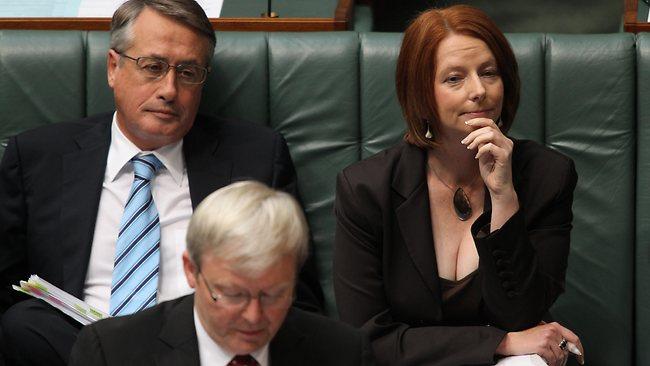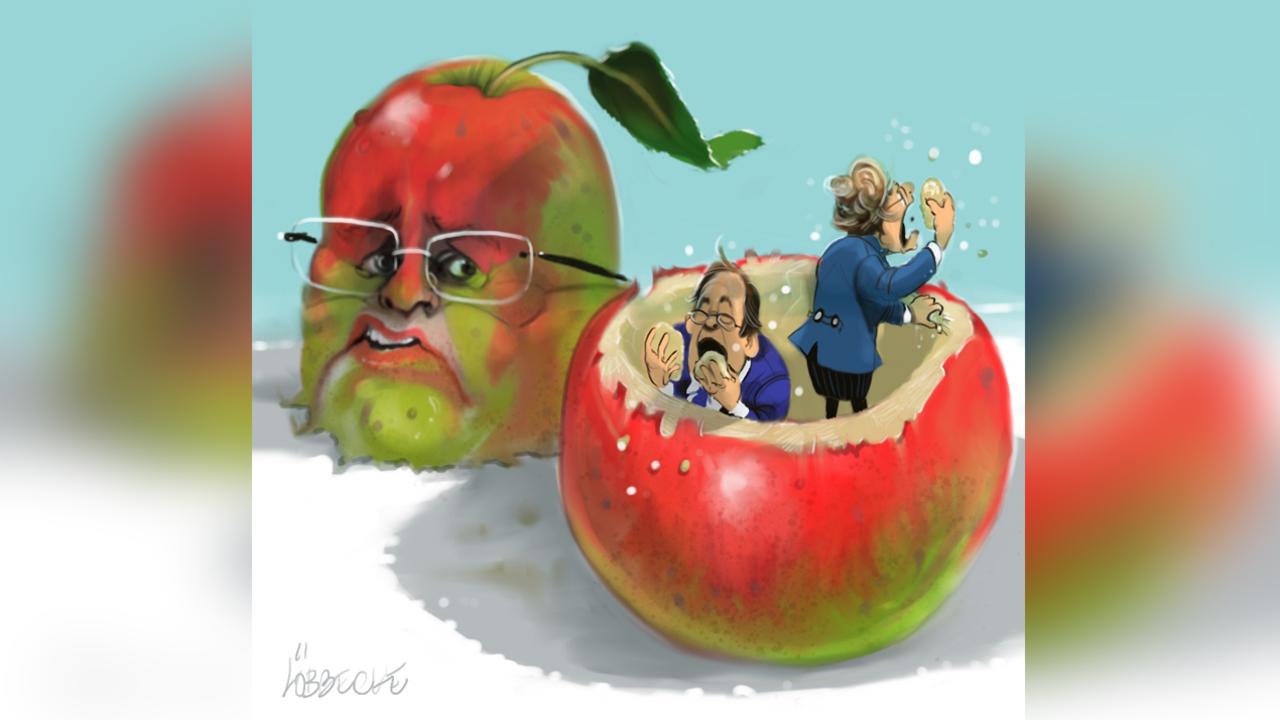
ON November 14, 2007, Labor launched its "economically conservative" fiscal policy. In only 10 lines of text, long since removed from the ALP's website, Kevin Rudd and Wayne Swan's media release repeatedly contrasted Labor's promised "restraint" and "discipline" with John Howard's "reckless spending".
Six years later, Labor leaves Australia's fiscal prospects in tatters, with structural budget deficits stretching out as far as the eye can see.
Achieving this required a sequence of catastrophic misjudgments. But like bad art, bad economic policy doesn't just happen: people do it, and for a reason. However inept Labor's decisions may have been, and however incorrect its estimate of the changing outlook, those decisions were constantly shaped by the search for immediate political advantage: to use the situation to reward friends and punish enemies, lock in key constituencies at the expense of those it had written off, and in the process damage the opposition.
Politics was not just the main thing: it was the only thing. Combined with a vast overestimate of their own abilities and of the power of the instruments on which they could rely, Rudd, Julia Gillard and Swan have engaged in ceaseless tactical manoeuvring that has shredded any notion of fiscal strategy, trashed public confidence in economic policy, and tarnished the role and standing of Treasury. And to make matters worse, the government's bequest to its successor is a tax and expenditure system far more distorted and distorting than that which it had inherited. For the first time since the 1980s, our economic institutions have gone backwards.
None of that is to deny the challenges Labor faced on taking office. Its claim during the 2007 election that "the inflation genie was out of the bottle" was an exaggeration, but there had been a build-up of inflationary pressures, not merely in Australia but internationally. Yet within six months the US was in recession, as were large parts of Europe, while the global financial system lurched towards the Lehman Brothers bankruptcy of September 15, 2008. A government of neophytes was faced with a world economy that had suddenly turned menacing, confused and uncertain.
The initial $10 billion stimulus package, launched in October 2008, seemed a not unreasonable response to those uncertainties. It should have provided the government with comfort that it could wait and see how the situation developed, all the more so as the Australian financial system was in relatively strong shape, there was ample scope for further monetary easing and the labour market still had the flexibility to absorb significant shocks.
The government could, in other words, have taken a leaf out of Peter Costello's measured response to the 1997 Asian financial crisis and to the 2001 "tech wreck", retaining the flexibility to react while keeping policy on sustainable long-term settings. Instead, on February 3, 2009, the government announced that the Nation Building and Jobs Plan would inject an additional $40bn into the Australian economy, quadrupling the already large initial stimulus package. That the plan was poorly conceived was apparent from the outset. Bad enough that the forecasts of growth on which it was based seemed unduly pessimistic, as they soon proved to be. What was worse was that it committed the government to very poor quality spending that could not possibly be deployed in time to offset the expected downturn. Even from the scant information the government released, it was obvious programs such as the home insulation scheme and Building the Education Revolution were so badly designed they could only end in tears.
The fraud-ridden pink batts program caused four deaths and cost nearly half a billion dollars to clean up. As for BER, the government implausibly claimed more than 70 per cent of the outlays would be made before mid-2010, implying the average dollar would be spent within 300 days. In fact, the average project took 560 days to go from planning to reality, while the larger, more significant projects took an average of two years. The unsurprising result was that when the lowest quarterly gross domestic product growth rate occurred in the December quarter of 2008, less than 20 per cent of the stimulus money had been spent. The nation was therefore frantically building school halls - many unneeded, most a depressingly poor use of the education dollar - long after the economy had returned to strong growth. Stupidity has its heavyweights, but the stimulus spending did not squander taxpayers' resources randomly. This was no helicopter evenly sprinkling cash on the grateful masses; rather, each element was targeted to constituencies Labor wanted to seize and hold. BER and pink batts took that to extremes, focusing its generosity on the building trades that had formed the core of the Howard government's aspirational voters. Given the delays in which those programs were mired, the effect was to aggravate the skill shortages mining faced just as the resource boom got under way.
But ill-advised as the second stimulus package was, the 2009-10 budget did paint a reasonably honest picture of the fiscal outlook, projecting a 2011-12 deficit of $44bn. However, that honesty proved short-lived: with the 2010 election approaching, the government dramatically changed its tune.
In 2009-10, it had forecast steady but not spectacular revenue growth; by the time of the 2010-11 budget, revenues were projected to increase by 10.7 per cent in 2011-12, a growth rate not seen since the mid-1980s. As Gillard and Tony Abbott confronted each other, that claimed revenue bonanza allowed Labor's mantra to become its promise of a return to surplus "in three years, three years early". Far from recoiling from the cross of fiscal rectitude, the vampire had seized that cross and made it its own.
Yet promises are one thing, reality another. While expenditure growth slowed, it remained at a trend annual rate of nearly 5 per cent; given the size of the initial deficit, revenue increases were hardly likely to rapidly close the gap. Always a chimera, the promised surplus therefore vanished as abruptly as it had arrived.
The government's explanations for the surplus's disappearance were vacuous at best and disingenuous at worst, but at least they cannot be accused of overestimating the intelligence of the Australian public. The mining tax, it has claimed, failed to generate rivers of gold because mining profits are cyclical; indeed they are, but a steep downturn was apparent many months ago. As for disappointing company tax receipts, the Treasurer's latest culprit is the exchange rate: but that is virtually the only parameter the 2012-13 budget got right, projecting that the dollar would be worth $US1.03 (as it is) and that the trade weighted index would be within 1 per cent of where it now stands.
As for Finance Minister Penny Wong, she prefers the incomprehensible, blaming the shortfall on the fact nominal GDP has been growing less rapidly than real (that is, inflation adjusted) GDP. But that explanation makes little sense, for statistical analysis shows it was only in the high inflation period of the 70s and early 80s that changes in nominal GDP had a greater impact on tax receipts than changes in real GDP.
Rather, Labor's problem is that once it started spending to stimulate the economy, it could not stop. In its 2011-12 budget, it pledged to "hold real growth in spending to 2 per cent a year until the budget returns to surplus". Had that pledge been respected, the deficit would have been almost entirely eliminated; instead, in its rush to buy one constituency after the other, the government simply ignored that goal, with real spending rising in 2011-12 alone by 4.8 per cent.
Little wonder the latest data suggest government outlays are running at 24.6 per cent of GDP - well above the government's target of 23.8 per cent for this financial year and higher than in every year of the Howard government except three (1996-97, 2000-01 and 2001-02). And little wonder the budget bottom line looks so grim, despite tax revenues substantially higher than those the government expected in 2009-10.
Yet the damage goes far beyond the immediate budget outlook. When they claimed to be "fiscal conservatives", Rudd and Swan set out a fiscal rule based on that implemented under Howard. Once elected, however, they treated rules as made to be broken, changing both the constraint and its formulation each and every time it suited their needs. The consequence is a complete lack of predictability in fiscal policy, undermining business confidence.
Even more difficult to correct will be the harm done to the tax system.
To begin with, Labor, while locking in rising expenditure commitments, has made the tax base ever more vulnerable to cyclical swings in the economy. Our public revenues were already more dependent on taxing profits, and therefore investment, than those in any other advanced economy; Labor made that dependence yet more pronounced.
At the same time, our tax system has become even less efficient. Far from cutting the company tax rate, as the Henry review recommended, the government increased it through a series of poorly disguised technical changes, as well as imposing the minerals resource rent tax. As for personal income tax, the changes introduced with the carbon tax reduced the number of people who pay any income tax, while increasing effective marginal rates for more than two million who do, weakening the incentive to work and save.
The overall outcome is a personal tax system where many pay nothing at all, intensifying the political pressure they impose for higher public spending, while others pay more than they have for years. While these calculations are inherently complex, the tax rate payable on average incomes, taking into account the proposed levy for DisabilityCare, will have risen from just over 21 per cent of average weekly earnings in 2008 to nearly 23.5 per cent of those earnings in 2014. And given changes such as those to the Medicare levy surcharge and to superannuation, effective marginal rates facing middle and upper income earners are likely to be higher now than at any time since the 80s.
Labor, in other words, has done everything it could to institute a fiscal class war, with middle-income earners caught in the cross-fire. And even with that, it leaves substantial, largely unfunded, obligations in its health, disability and education programs, where current shortfalls will have to be covered by future generations. It is difficult to imagine a greater contrast to the prudent, inclusive and reforming image Labor so successfully projected in 2007.
On top of all that, serious damage has been inflicted on our key economic policy institutions, most notably the Treasury. It has been a striking feature of this government that it invariably sought to make officials responsible for its policies. One can no more imagine Paul Keating or Costello suggesting they were merely doing what Treasury recommended than one can imagine them walking on the moon: they were the ones who took the decisions, and they were the ones responsible. Yet scarcely a week passes without Gillard, Swan and Wong hiding behind Treasury's coattails.
But if the government coaxed Treasury on to the stage, Treasury showed no sign of stage fright. Savouring the smell of the grease paint and the roar of the crowd, it blurred the lines between faithfully expressing government policy and becoming its belligerent advocate, all too readily taking the credit in the days when there was credit to take. Victims of the process that converts thong-wearing radicals into gong-wearing mandarins, its officials proved epitomes of well-intentioned arrogance.
That Treasury made so many errors along the way will not help it regain its standing. But the greatest of those errors was not in its forecasts, for to forecast is inevitably to err.
It was in downplaying the uncertainty of the situation and the limits that imposed on the instruments at hand, and most notably on discretionary fiscal policy. With control over monetary policy having been vested in the Reserve Bank, that was the instrument Treasury controlled; it consistently oversold its agility, efficacy and efficiency, touting what proved to be a blunderbuss as a laser missile.
At least on recent polling, Gillard, who has proved as unfortunate in her choice of friends as she was of enemies, will soon have plenty of time to reflect on this saga's lessons, as will the pocketbook Machiavellis who plotted and implemented Labor's strategy. But even if the election turns into a contest in fiscal perjury, the past six years surely show that while the big lie can succeed remarkably as a short-term tactic, it is a disastrous road to political authority. The most important lesson, however, is also the oldest: that the art of governing lies in doing as little as possible, as much as necessary, and the wisdom in knowing how to distinguish between these.
This Labor government, like that of Gough Whitlam, proved incapable of that task. It will take another generation in the Labor Party to pick up the pieces.



